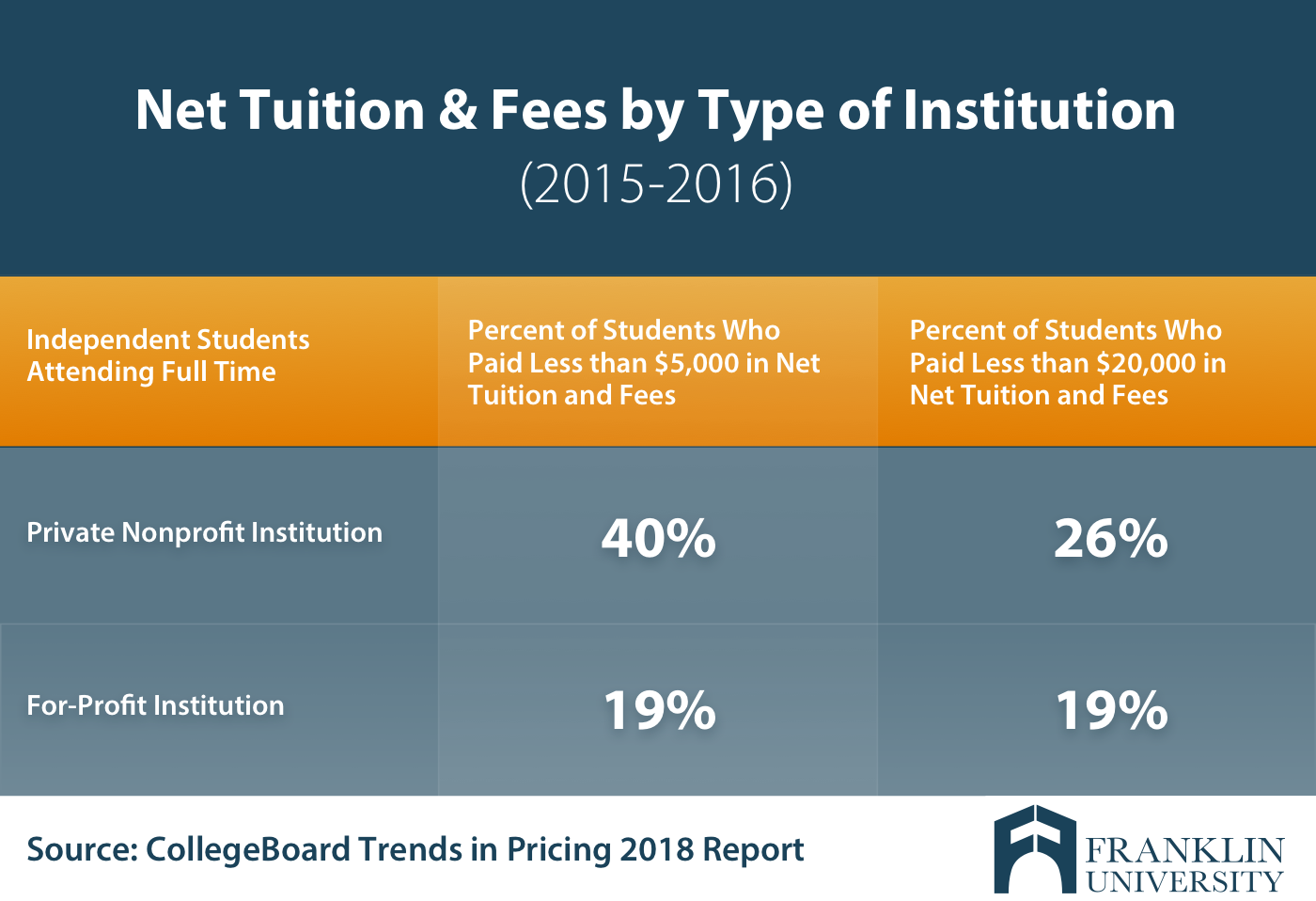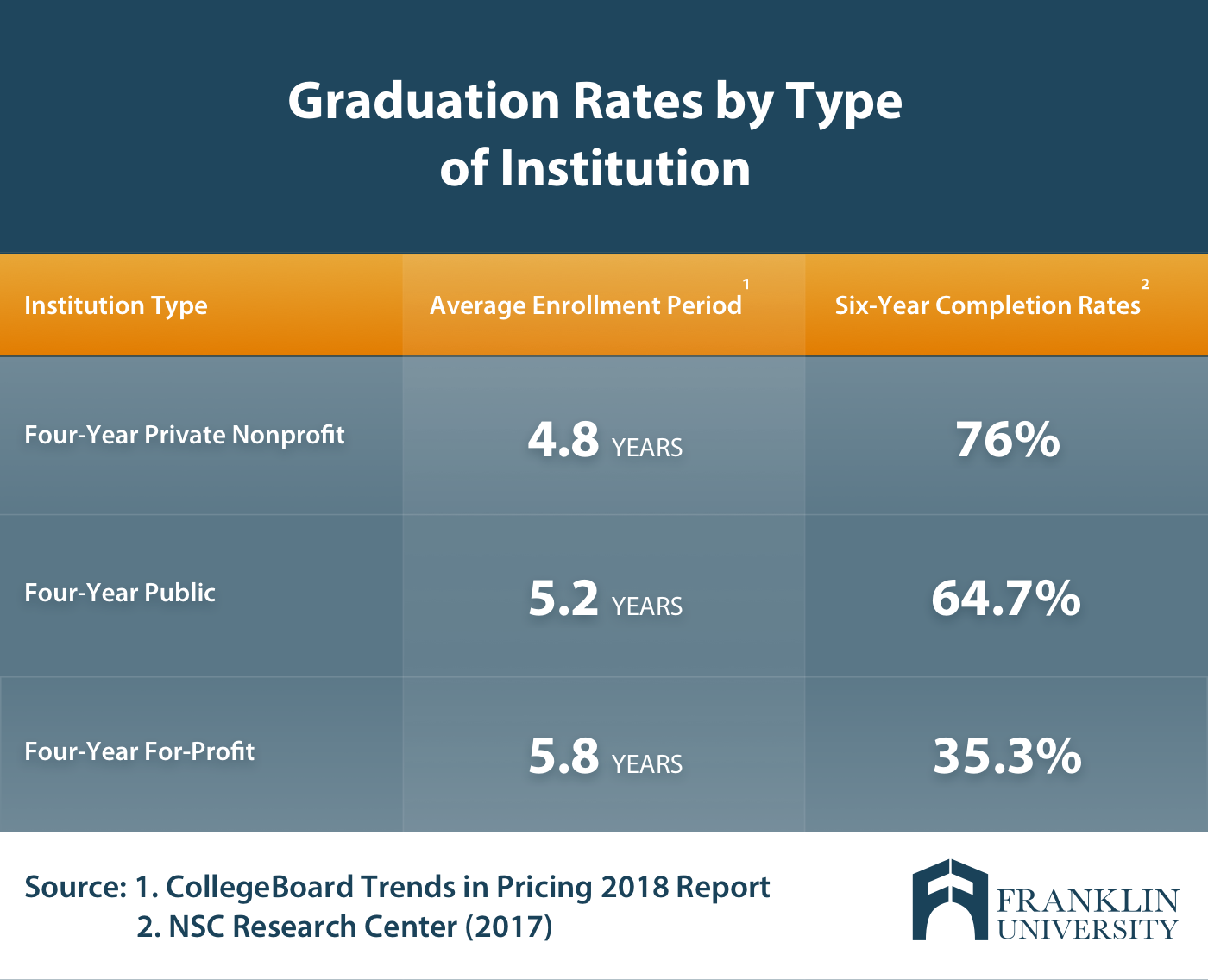what information is a private for profit college required to disclose

Non-Turn a profit vs. For-Profit Colleges: What You lot Need to Know
Between 1990 and 2010, the percentage of bachelor'southward degrees earned from for-profit schools increased 7-fold. Their success was primarily based on their power to uniquely address the needs of nontraditional students. Only by 2015, Corinthian Colleges, once the second-largest for-profit college concatenation in the country, went bankrupt, while the Academy of Phoenix'due south enrollment dropped past 50%.
How did this change happen so rapidly?
Instituting the Gainful Employment Rule
The Gainful Employment (GE) Rule (as it's commonly called) was instituted in 2014. Nether GE, students risked losing admission to federal fiscal aid if debt-to-earnings ratios of graduates from their school exceeded certain levels.
So, what did GE mean for schools?
The regulation required for-profit institutions to disclose specific data to prospective students for all their caste and certificate offerings, including program costs, debt of graduates and program length. Public and private, nonprofit institutions, meanwhile, were required to post the same information, simply for their not-degree offerings only.
(GE has since been rescinded, with Education Secretarial assistant Betsy DeVos issuing a final repeal of the regulation on June 28, 2019.)
The Lasting Bear on of the Gainful Employment Rule
While some for-profit colleges went out of business, some others have merged, rebranded, or applied to become nonprofit institutions. Enrollment at these schools, meanwhile, continues a steep decline—dropping xix.7% year-over-twelvemonth from spring 2018 to spring 2019 (Relate of Higher Education). At the same fourth dimension, nonprofit colleges and universities have made sizeable investments in coming together the needs of nontraditional students with robust online courses and student support services.
So, where do for-profit schools stand up today and how do they compare to their nonprofit peers? Allow's expect at how nonprofit colleges and for-turn a profit colleges have evolved and what that ways to a prospective educatee.
Online Colleges and For-Profit Colleges Are Not the Aforementioned
Information technology's a common misconception that all online colleges are for-profit. While for-profit colleges are frequently credited with spurring the popularity of online courses, today, about every nonprofit college or university offers some form of distance learning. Fifty-fifty more, there are many nonprofit online colleges that specialize in creating flexible caste programs that meet the needs of adults juggling jobs, family unit and life.
But with more options than ever, you need to understand how the nonprofit vs. for-profit condition of an online college or university can bear on you as a student, and then you can choose a program that'south correct for y'all.
For-Profit Colleges Spend Significantly Less Revenue on Educating Students Than Nonprofit Colleges
When you pay your tuition and fees, where practise those dollars go?
At for-turn a profit colleges, a significant portion of tuition revenue goes directly to investors or other not-educational activity related spending, like advertisement and marketing. Creating a positive return on investment is how for-profit colleges stay in concern.
At nonprofit colleges, revenue must be reinvested into the institution—whether that'southward improving operations, instructor salaries, library resources or pupil services—to fulfill its educational mission.
And there's data to support how much of your tuition dollars go direct to pupil instruction and didactics-related spending. The Century Foundation (TCF) took on a comprehensive effort to evaluate instructional spending equally a percentage of tuition collected at every higher teaching institution.
TCF found that for-profit colleges spend the to the lowest degree on instruction, generally less than half of overall tuition revenue. Some of the lowest instructional spending was found at for-turn a profit colleges with large online enrollment. Nonprofit colleges, on the other hand, spend the majority of tuition dollars on enhancing the academic feel. When teaching-related spending, like pupil services and academic support, is taken into account, nonprofit institutions actually invest more than money, on average, than they receive in tuition.

Here'south a existent-world case of the nonprofit business model at work.
"At a nonprofit university, student success is our lifeblood," says Dr. Lynne Hull, vice president of Student Affairs at Franklin University, "A pregnant portion of our university's spending goes toward efforts to keep curriculum and teaching methods on the cutting-edge, while supporting our students every step of the way."
Hull goes on to describe the types of investments Franklin Academy tin can make because of its nonprofit condition, "Nosotros have extremely engaged program informational boards who tell us well-nigh workforce demands and then our curriculum is always fresh and up-to-date. We employ practitioners to develop and teach courses, and so you're learning straight from people who are leaders in their field. We hire experts in teaching and learning who constitute pedagogy best practices and pattern engaging online learning environments. This type of reinvestment directly impacts the student experience."
Out-of-Pocket Costs Are Less at Nigh Nonprofit Colleges
Tuition and fees at both for-profit and nonprofit colleges and universities may seem daunting. As tuition rates steadily increase, determining how you'll pay for your education, for many people, is a major influence in choosing a college.
When comparing tuition, at that place are two ways to look at information technology: published tuition and fees and net tuition and fees.
- Published tuition and fees are the total toll of attendance before any fiscal aid is considered.
- Internet tuition and fees are a higher'southward published sticker prices for tuition and fees minus the grants, scholarships, and education tax benefits received. Some net tuition and fee statistics take loans into account.
When information technology comes to paying for schoolhouse, grants are among your best options. Simply practise you know how to observe them? Remove the guesswork by downloading this costless guide.
Rarely do students pay full price for their education. According to Money Mag, just 12% of private college students pay the full toll of published tuition and fees.
As reported in the CollegeBoard Trends in Pricing 2018 Report, at all income levels, larger shares of full-time students at private nonprofit colleges and universities than at for-profit institutions paid net tuition and fees less than $5,000 in 2015-sixteen.
In fact, 66% of students pay less than $20,000 in internet tuition and fees at private nonprofit institutions yearly, equally opposed to 31% at for-turn a profit institutions.

Most Students Spend Less Fourth dimension Earning Their Degree at Nonprofit Colleges
Another consideration when planning for the price of a degree is how long it will have you to earn your caste. While many people budget for a four-twelvemonth undergraduate pedagogy, averages indicate that most students do not complete a degree in 4 years.
The difference between graduation rates at four-year nonprofits and four-year for-profits is staggering. For-profit boilerplate enrollment, at 5.8 years, is a full year longer than four-year individual nonprofits at 4.8 years. 4-yr nonprofit colleges likewise far exceed for-profit colleges in six-year completion rates. Where 76% of students complete a caste in vi years at 4-year individual nonprofits, only 35.3% of students graduate in six years at for-profit colleges.

How to Choose the Right College For You lot
If you're looking to pursue an online degree, y'all'll probably compare nonprofit universities with for-profit universities. Here are a few tips to help you determine the quality of the program—regardless of its nonprofit or for-profit status.
- Review the college or academy's accreditation status through the U.S. Department of Education
- Research graduation rates and employment data. American Institutes for Enquiry provides data on higher education institutions that may be useful.
- Review curriculum and instructors to ensure they are well established and respected
- Talk with colleagues and mentors about their college experience. Getting insights from people you trust and admire tin can be extremely helpful in making your decision.
Once you ensure a college or university will provide a loftier-quality degree, you can choose a programme that volition give you the knowledge and skills to reach your career goals.
Franklin University is a regionally accredited academy that is dedicated to the success of nontraditional students, especially professionals who want the flexibility to earn a high-quality online degree without taking fourth dimension out from their career. Explore Franklin Academy'south degree programs to meet how they can help you reach your professional person goals.
galesdevescithhen.blogspot.com
Source: https://www.franklin.edu/blog/non-profit-vs-for-profit-colleges-what-you-need-to-know
0 Response to "what information is a private for profit college required to disclose"
Post a Comment